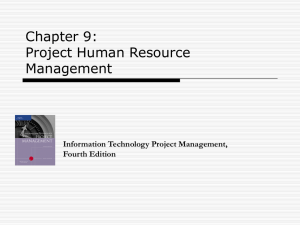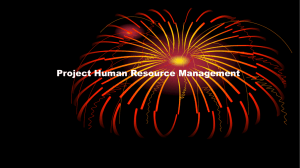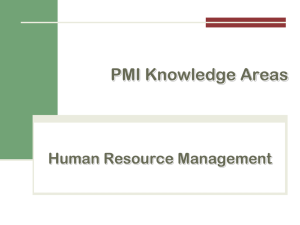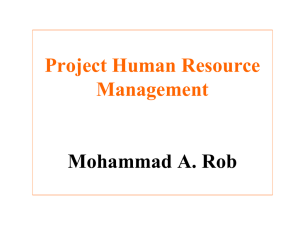Lesson 16
advertisement
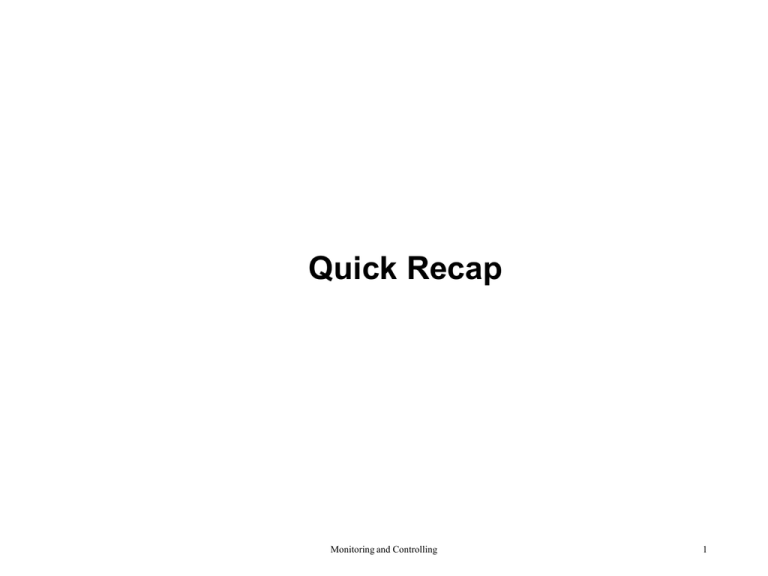
Quick Recap Monitoring and Controlling 1 Project Quality Management Summary 2 Lesson 6: Planning Project Quality, Staffing, and Communications Topic 6B: Document the Project Roles, Responsibilities, and Reporting Relationships Topic 6C: Create a Communications Management Plan “Roles and Responsibility” as Monitoring and Controlling Approach Organizational Planning Involves identifying and documenting project roles, responsibilities, and reporting relationships. Outputs include: Project organizational charts Staffing management plans Responsibility assignment matrixes Resource histograms Figure 9-2. Sample Organizational Chart for a Large IT Project 6 Figure 9-3. Work Definition and Assignment Process 7 Responsibility Assignment Matrixes A responsibility assignment matrix (RAM) is a matrix that maps the work of the project, as described in the WBS, to the people responsible for performing the work, as described in the OBS. Can be created in different ways to meet unique project needs. 8 Roles and Responsibilities Role Responsibility Initiator Initiates the workflow. Responsible for defining the workflow and identifying the reviewer(s) and approver. Attaches draft version of document(s) to be approved. Reviewer Reviews the approval documents, saves the document locally, makes changes directly to the documents (using WORD track changes), and uploads the updated document into the shared repository. Modifies data fields and enters notes, as appropriate. Accepts document, when complete, to send workflow to remaining reviewers or for approval. Delegated Resource Executes the workflow as directed by the reviewer or approver. Delegates the workflow back to the reviewer or approver when complete. Approver Reviews the execution of the workflow by each reviewer. Reviews the final approval document. Either accepts the workflow to close it or requests further review. Program Owner Views, tracks progress, and reports on workflows within the respective program. Administrator Views, tracks progress, and reports on all workflows Super User Administers workflows as appropriate, including reassignment, cancellation, and deletion. 9 Figure 9-4. Sample Responsibility Assignment Matrix (RAM) 10 Figure 9-5. RAM Showing Stakeholder Roles 11 Table 9-1. Sample RACI Chart R = Responsibility, only one R per task A = Accountability C = Consultation I = Informed 12 Staffing Management Plans and Resource Histograms A staffing management plan describes when and how people will be added to and taken off the project team. A resource histogram is a column chart that shows the number of resources assigned to a project over time. 13 Figure 9-6. Sample Resource Histogram 14 Acquiring the Project Team Acquiring qualified people for teams is crucial. The project manager who is the smartest person on the team has done a poor job of recruiting! Staffing plans and good hiring procedures are important, as are incentives for recruiting and retention. Some companies give their employees one dollar for every hour that a new person who they helped hire works. Some organizations allow people to work from home as an incentive. 15 Why People Leave Their Jobs They feel they do not make a difference. They do not get proper recognition. They are not learning anything new or growing as a person. They do not like their coworkers. They want to earn more money. 16 Resource Loading Resource loading refers to the amount of individual resources an existing schedule requires during specific time periods. Helps project managers develop a general understanding of the demands a project will make on the organization’s resources and individual people’s schedules. Overallocation means more resources than are available are assigned to perform work at a given time. 17 Figure 9-7. Sample Histogram Showing an Overallocated Individual What’s wrong with this picture? Assume 100 percent means Joe is working eight hours per day. 18 Resource Leveling Resource leveling is a technique for resolving resource conflicts by delaying tasks. The main purpose of resource leveling is to create a smoother distribution of resource use and reduce overallocation. 19 Figure 9-8. Resource Leveling Example 20 Benefits of Resource Leveling When resources are used on a more constant basis, they require less management. It may enable project managers to use a just-in-time inventory type of policy for using subcontractors or other expensive resources. It results in fewer problems for project personnel and the accounting department. It often improves morale. 21 Developing the Project Team The main goal of team development is to help people work together more effectively to improve project performance. It takes teamwork to successfully complete most projects. 22 Tuckman Model of Team Development Forming Storming Norming Performing Adjourning 23 Training Training can help people understand themselves and each other, and understand how to work better in teams. Team building activities include: Physical challenges Psychological preference indicator tools 24 Myers-Briggs Type Indicator (MBTI) MBTI is a popular tool for determining personality preferences and helping teammates understand each other. Four dimensions include: Extrovert/Introvert (E/I) Sensation/Intuition (S/N) Thinking/Feeling (T/F) Judgment/Perception (J/P) NTs, or rationals, are attracted to technology fields. IT people vary most from the general population in their tendency to not be extroverted or sensing. 25 Wideman and Shenhar’s Views on MBTI and Project Management* Most suited for project leadership: 100 percent: INTJ, ENTJ, ISTJ, ESTJ 50 percent: INTP, ENTP, ENFP, ENFJ Best suited as followers: 100 percent: INFJ, ISFJ 50 percent: INTP, ENTP, ENFP, ENFJ, ESFJ Not suited for project work: 100 percent: INFP, ISFP, ESFP, ISTP 50 percent: ENFP, ESTP *Wideman, R. Max and Aaron J. Shenhar, “Professional and Personal Development: A Practical Approach to Education and Training,” Project Management for Business Professionals, edited by Joan Knutson, 2001, p. 375. 26 MBTI and Suitability to Project Work* What do you think about these views? *Wideman, R. Max. “Project Teamwork, Personality Profiles and the Population at Large: Do we have enough of the right kind of people?” (http://www.maxwideman.com/papers/profiles/profiles.pdf ). 27 Social Styles Profile People are perceived as behaving primarily in one of four zones, based on their assertiveness and responsiveness: Drivers Expressives Analyticals Amiables People on opposite corners (drivers and amiables, analyticals and expressives) may have difficulty getting along. 28 Figure 9-9. Social Styles 29 Reward and Recognition Systems Team-based reward and recognition systems can promote teamwork. Focus on rewarding teams for achieving specific goals. Allow time for team members to mentor and help each other to meet project goals and develop human resources. 30 Managing the Project Team Project managers must lead their teams in performing various project activities. After assessing team performance and related information, the project manager must decide: If changes should be requested to the project. If corrective or preventive actions should be recommended. If updates are needed to the project management plan or organizational process assets. 31 Tools and Techniques for Managing Project Teams Observation and conversation Project performance appraisals Conflict management Issue logs 32 General Advice on Teams Be patient and kind with your team. Fix the problem instead of blaming people. Establish regular, effective meetings. Allow time for teams to go through the basic teambuilding stages. Limit the size of work teams to three to seven members. 33 General Advice on Teams (cont’d) Plan some social activities to help project team members and other stakeholders get to know each other better. Stress team identity. Nurture team members and encourage them to help each other. Take additional actions to work with virtual team members. 34 Using Software to Assist in Human Resource Management Software can help produce RAMS and resource histograms. By using project management software for human resource management, you can: Assign resources. Identify potential resource shortages or underutilization. Level resources. 35 Project Resource Management Involves Much More Than Using Software Project managers must: Treat people with consideration and respect. Understand what motivates people. Communicate carefully with people. Focus on your goal of enabling project team members to deliver their best work. 36 Topic 6C: Create a Communications Management Plan What is Project Communication • Exchange of Project-specific information What’s in it for you? Three reasons you need to manage project communication • Meet the information needs of your project stakeholders (Communication Planning and Information Distribution) • Track and report on project performance (Performance Reporting) • Formally document project results (Administrative Closure) Project Communication Management Communication Planning Initiating Processes Planning Processes View Project Communication in the context of the five PM process groups. Performance Reporting Information Distribution Executing Processes Controlling Processes Administrative Closure Closing Processes Communication Planning • Inputs – Project Charter and WBS Product List • Process – Identify stakeholders and their information needs – Identify WBS Products – Complete Project Communication Plans • Outputs – Project Communication Plan – Conflict Management Plan • Tools – Project Communication Handbook and Project Communication Planning Website Project Communication Plan • Identifies the project team • Explains methods of communication including community involvement • Provides project reporting information • Stakeholders analysis • Communication Matrix Communication Matrix • WBS Products by WBS Number • Identifies the Uniform Filing System Location for each product listed (an X indicates it belongs in the permanent project history file) • Completed for each phase • Can be downloaded from the Intranet (Available on PM Website) • The Communication Matrix provides a roadmap for the project Conflict Management Plan • Provides guidelines for resolving conflicts during the life of a project • Developed with project stakeholders • Record decisions made • Design interest-based conflict management strategies with stakeholders, not for them Information Distribution • Communication skills are used to exchange project information – Senders are responsible for ensuring messages are clear and understood • Project team members are suppliers and customers – Suppliers provide inputs – Task managers deliver WBS elements – Customers receive the products • Track product deliverables with the Communication Matrix What Project Team Members Need to know • If you are working on a project, you need to know: – Why your customers want your product – What features your customers want – How your customers want to receive it – How long it will take • Tell your customers exactly when deliverables will arrive - extremely important for critical path elements • Project Team members ensure successful product delivery Performance Reporting • Status Reporting – Where the project stands at a given point • Progress Reports/Work Results – What the project team has accomplished to date • Change Requests – Analysis may result in request for a change • Important to keep workplans and project databases current for accurate project reporting Administrative Closure Each project phase requires closure • Close-out Processes - Verify and document project results (Available on PM Website) • Uniform Filing Systems – Project Development and Construction maintain permanent history files • Lessons Learned - Provide feedback to continuously improve Project Delivery (Available on PM Website)
